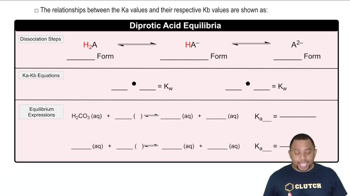Here are the essential concepts you must grasp in order to answer the question correctly.
Diprotic Acids
Diprotic acids are acids that can donate two protons (H⁺ ions) per molecule in an aqueous solution. The dissociation occurs in two steps, where each step involves the release of one proton. Understanding the behavior of diprotic acids is crucial for writing balanced equations, as each dissociation step must be represented separately.
Recommended video:
3 forms of Diprotic Acids
Net Ionic Equations
Net ionic equations represent the actual chemical species involved in a reaction, excluding spectator ions that do not participate in the reaction. To write a net ionic equation, one must first write the complete ionic equation and then eliminate the ions that appear on both sides. This concept is essential for accurately depicting the dissociation of acids in solution.
Recommended video:
Equilibrium Constants
Equilibrium constants (K) quantify the ratio of products to reactants at equilibrium for a given reaction. For diprotic acids, there are two equilibrium constants corresponding to each dissociation step. Understanding how to write and interpret these constants is vital for analyzing the strength of the acid and the extent of dissociation in solution.
Recommended video:
 Verified step by step guidance
Verified step by step guidance


